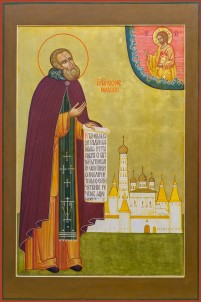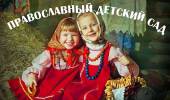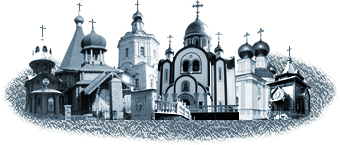Vidnovsky Deanery, Razvilka settlement

CHURCH NEWS -
IN SOCIAL NETWORKS:
Youtube вАУ Hramiosif Razvilka
VKontakte вАУ Hramiosif Razvilka
Joseph Volotskiy
Joseph Volotskiy - secular name Ioann Sanin - was born on November, 14 in 1440 or 1439 in a devout family of Ioann and Marina in Yazvishche-Pokrovskoye village under Volokolamsk. When Ioann was seven he was sent to the virtuous and enlightened elder (starets) of the Volokolamsk Cross Exaltation Monastery Arseny for instruction. Having brilliant memory, Ivan quickly learned to read and write and became the reader and singer of the monastic church. His contemporaries were stunned by his extraordinary memory. He had not a single book in his cell, but he could perform the monastic rule reading by memory the appropriate parts of the Psalter, the Gospel and the Apostle. At 20, Ioann left his parentsвАЩ home and joined the hermitage of ascetic Barsonophius not far from Tverskoy Savvin monastery. But he considered the monastic rule their not strict enough. With the blessing of the elder Barsonophius he leaves for Borovsk and joined the monastery under the supervision of the elder St. Paphnutius. The simple life of the saint elder, the work he shared with the brethren and strict monastic rule satisfied Ioann's spiritual mood. St. Paphnutius received the youth kindly and on 13 February 1460 admitted him as a coenobite under the name of Joseph. The young monk carried out his hard obediences in the kitchen, bakery and hospital. He revealed great spiritual talents in liturgical reading and singing. He was also talented in music and had a perfect command of his voice. St. Paphnutius made him soon ecclesiarch of the church to be responsible for keeping the monastic charter. Joseph spent in the monastery about eighteen years. These years of strict ascetic life under the supervision of experienced Farther Superior made him the future good counsellor and master of monastic life. After St. PaphnutiusвАЩ death (вА† May, 1-st, 1477), Joseph was ordained priestmonk and then appointed hegumen (Farther Superior) of the Borovsk monastery in accordance with the will of the deceased. St. Joseph decided to transform the monastic life by enforcing a very strict coenobitic rule similar to the Kiev-Pechersk, St. Sergius Trinity and St. Cyril Belozero monasteries. However, the rule turned out to be beyond the brothersвАЩ strength. Then, still determined to found a cloister with a strict coenobitic charter, he and a group of his followers set off for Volokolamsk forests that were familiar to him from his childhood. The prince of Volokolamsk was at the time the pious brother of Great Prince Ivan III, Boris Vasil'evich. Having heard about the virtuous life of the great ascetic Joseph, he gladly received him and allowed him to settle on the outskirts of his principality, at the confluence of the Rivers Struga and Sestra. The selection of this spot was accompanied by a remarkable occurrence: a storm blew down the trees before the eyes of the astonished travellers, as though clearing the place for the future monastery. And right there ascetics erected a cross in June 1479 and sited a wooden church in honour of the Uspenie (Dormition) of the Mother of God, consecrated on 15 August 1479. This day and year stand in history as the date of Dormition of the Most Holy Mother of God monastery foundation on Volok Lamsk ("broken-up peninsula"), later named after its founder. The monastery was built quite quickly. Much of the monastery construction works was done by the founder himself. "He was skilled in every human craft: he felled trees, carried logs, he chopped and sawed". By day he toiled with everyone at the monastery construction, nights he spent in solitary cell praying, remembering always, that "the carnal desires of the lazy can kill" (Prov. 21: 25). Good reports about the new ascetic attracted disciples to him. The number of monks soon increased up to hundred, and Abba Joseph strove to be a good example for his monks in everything. Preaching temperance and spiritual sobriety in everything, he was not externally distinct from the others вАУ his simple, thin tatters were his constant clothing, and bast-shoes served as his footwear. He was the first to appear in church, he read and sang in the choir along with the others, he spoke instructions and was the last to leave church. At nights the holy hegumen walked round the monastery and the cells, safeguarding the peace and prayerful sobriety of the brethren entrusted him by God; if he happened to hear a frivolous conversation, he knocked on the door and modestly withdrew. Reverend Joseph devoted great attention to the inner ordering of the monks' life. He introduced a strict common-form life in accordance with the "Ustav" ("Rule") compiled by him, to which all the services and obediences of the monks were subordinated, and it governed their whole life: "whether in their comings or goings, their words or their deeds". At the core of the Ustav was total non-covetousness, detachment from one's own will together with constant work. The brethren possessed everything in common: clothing, footwear, food and other things. Without the blessing of the hegumen, none of the brethren could take anything into their cell, not even a book or an icon. Part of their meal the monks by agreement was given away to the poor. Work, prayer, spiritual efforts filled the life of the brethren. The Jesus Prayer never left their lips. Festivity was considered by Abba Joseph as a chief weapon of demonic seduction. Reverend Joseph invariably imposed upon himself the heaviest obediences. The monastery was much occupied with copying of Divine-service books and those of the holy fathers, so that the Volokolamsk book collection soon became one of the finest of Russian monastic libraries. With each passing year the monastery of Reverend Joseph flourished all the more. In the years 1484-1485 a stone church of the Dormition of the Mother of God was erected in place of the wooden one. In the summer of 1485 "artistic masters of the Russian land" painted it, вАУ Dionysius the Iconographer with his sons Vladimir and Theodosius. Also the Reverend Joseph's nephews and disciples вАУ Dositheus and Vassian Toporkov - participated in the icon fresco-painting of the church. In 1504 was founded a heated refectory church in honour of the Holy Theophany, then a bell-tower was erected and under it вАУ a temple in the name of the Hodegetria Most Holy Mother of God. The reverend Joseph trained a whole school of famous monks. Some of them made themselves known in the arena of church-historical activity вАУ they were "good pastors", while others gained fame with works of enlightenment, some left after them a devout memory and were a worthy example of pious monastic efforts. History has preserved for us the names of many disciples and co-ascetics of the holy Volokolamsk hegumen, who afterwards continued to develop his ideas. Among the disciples and followers of the reverend Joseph were: the Metropolitans of Moscow and All Russia вАУ Daniel (вА† 1539) and Makarius (вА† 1563), the Archbishop of Rostov Vassian (вА† 1515), the Bishops вАУ Simeon of Suzdal (вА† 1515), Dositheus of Krutitsk (вА† 1544), Savva of Krutitsk also known as the Black, Acacius of Tver, Vassian of Kolomna, and many others. Monks of the Iosifo-Volokolamsk monastery occupied successively the most important archbishop cathedras of the Russian Church: prelates of Kazan вАУ Gurias (вА† 1563, Comm. 5 December) and German (вА† 1567, Comm. 6 November), and prelate Barsonophius, Bishop of Tver (вА† 1576, Comm. 11 April). The activity and influence of the Reverend Joseph were not limited to the monastery. Many a layperson went to him to receive advice. With a pure spiritual insight he penetrated into the deep secrets of the questioners' souls and perspicaciously revealed to them the will of God. Everyone living around the monastery considered him their spiritual father and protector. Eminent boyars and princes invited him as god-father for their children, they revealed to him their souls in confession, they asked for letters of guidance for fulfilling his directives. The common folk found at the monastery the means for sustaining their existence on occasions of extreme need. The number of those fed by monastery resources approached sometimes up to 700 people. The monastery was famous not only for its piety and help for the suffering, but also for manifestations of the grace of God. The righteous monk Vissarion once saw the Holy Spirit in the form of a white dove at the matins-service of Great Saturday, sitting upon the Shroud of Christ, which was being carried by the reverend Abba Joseph. The hegumen, asking the monk to keep silent about the vision, rejoiced himself in spirit, hoping that God would not forsake the monastery. This very monk had seen the souls of dying brethren, white like snow, issuing from their mouths. The day of his end was revealed to himself, and he reposed with joy, having communed the Holy Mysteries and took the schema. The life of saint Abba Joseph was neither easy nor placid. In the difficult times for the Russian Church, the God raised him up as a zealous advocate for Orthodoxy in the struggle with heresies and church disagreements. The reverend Joseph exerted quite a great effort in denunciation of the Judaisers, who tried to poison and distort the foundations of Russian spiritual life. Just as well as the holy fathers and teachers of the Oecumenical Church had elaborated the dogmas of Orthodoxy responding against the ancient heresies (which contended against the Spirit, Christ, or icons), so saint Joseph was summoned by God to oppose the false teachings of the Judaisers and to compile the first codex of Russian Orthodox theology вАУ his great book "The Enlightener" ("Prosvetitel'"). Preachers from among the Khozars had come already to the saint Equal-to-the-Apostles Vladimir, trying to convert him to Judaism. But the great Baptiser of Russia repudiated the pretensions of the rabbis. After this, the reverend Joseph writes, "the Great Russian land dwelt for five centuries in the Orthodox faith, until the enemy of salvation, the devil, should bring the cunning Jew to Great Novgorod". The Jewish preacher Skhariya (Zakhariya) came to Novgorod in 1470with the retinue of the Lithuanian prince Mikhail Olel'kovich. Taking advantage of the incompleteness of faith and learning of some of the clergy, Skhariya and his accomplices sowed distrust among the poor-spirited towards the church hierarchy, they inclined them towards a revolt against the spiritual authorities, they tempted them with the idea of "self-authority", i.e. a personal capricious self-determination in matters of faith and salvation. Gradually those tempted were pushed towards a full break with Mother Church, to disdain holy icons, and to reject honouring of the Saints. Ultimately, they led the religiously blind and deluded to denial of the saving Sacramental-Mysteries and the fundamental dogmas of Orthodoxy, outside of which there is no knowing of God вАУ the dogma of the Most Holy Trinity and the dogma of the Incarnation. Great Prince Ivan III, enticed by the Judaisers, invited them to Moscow, he made two of the most prominent of the heretics archpriests вАУ one at the Uspensky, the other at the Arkhangelsky cathedrals of the Kremlin. All those close to the prince, beginning with the clerk heading the government, Theodore (Feodor) Kuritsyn вАУ whose brother became a ringleader of the heretics, were led astray by the heresy. Even the in-law of the great prince, Elena Voloshanka, accepted the Judaisers. And finally, the heretical metropolitan Zosima was introduced upon the cathedra of the great Moscow saint hierarchs Peter, Alexei and Jona. The reverend Joseph and prelate Gennadius, bishop of Novgorod (вА† 1505, Comm. 4 December) led the struggle against the spread of the heresy. The reverend Joseph wrote his first epistle "Concerning the Mystery of the Most Holy Trinity" while he was still a monk at the Paphnut'ev Borovsk monastery вАУ in 1477. The Uspensk Volokolamsk monastery became from the very beginning the stronghold of Orthodoxy in the struggle with the heresy. Here saint Joseph wrote his chief works, among them "The Enlightener" and his flaming anti-heretical epistles, or as he himself modestly called them, "exercise-books". The works of the reverend Joseph and saintly Archbishop Gennadius succeeded. In 1494 the heretic Zosima was deposed from the hierarch's cathedra, and in1502-1504 at a conciliar gathering were condemned the worst and unrepentant Judaisers, who blasphemed against the Holy Trinity, Christ the Saviour, the Most Holy Mother of God and the Church. Saint Joseph had many other trials and tribulations sent to him вАУ so the Lord tries everybody in the measure of their spiritual strength. The saint angered the Great Prince Ivan III, who only by the end of his life reconciled with the saint and repented of his former weakness for the Judaisers. The saint angered also the Volotsk prince Theodore, on whose lands Joseph's monastery was situated. In 1508 the monk suffered wrongful interdiction from saint Serapion, Archbishop of Novgorod (Comm. 16 March), with whom however he soon reconciled. In 1503 a Sobor (Council) at Moscow adopted a "Conciliar Answer" concerning the inviolability of church properties under the influence of the reverend Joseph and his disciples. The legacy of canonical works of the Volotsk hegumen is also "The Nomocanon Codex" вАУ a vast codex of canonical rules of the Orthodox Church, initiated by the reverend Joseph and completed by Metropolitan Makarius. There is an opinion about the differences of opinions and discord between the two great leaders of Russian monasticism at the end-XV - beginning XVI centuries вАУ the reverend Joseph of Volotsk and the reverend Nil of Sorsk (вА† 1508, Comm. 7 May). In the historical literature they are usually presented as proclaiming two "contrary" currents of Russian spiritual life вАУ external action and inner contemplation. This is profoundly incorrect. The reverend Joseph in his "Ustav" gave synthesis of Russian monastic tradition, proceeding without interruption from the Athonite blessing given to the reverend Antonius of Pechersk, through the reverend Sergiy Radonezhskiy and till present days. The requirement of full inward regeneration of man runs through "Ustav", submitting one's whole life to the task of salvation and "deification" ("obozhenie") not only for each individual monk, but also the collective salvation of the whole human race. A great emphasis in the "Ustav" is put on the demand to monks for constant work in conjunction with inward and churchly prayer. Work, as "a collective deed", comprised for Joseph the very essence of church life вАУ faith, embodied in good works, the realisation of prayer. On the other side, the reverend Nil Sorsky had himself asceticised for a number of years on Athos, and he brought from there the teaching about the contemplative life and "Mental Prayer" [i.e. the Jesus Prayer] as a means of an hesychiast service of monks to the world, as a constant spiritual activity, in conjunction with the physical work necessary for sustaining one's life. But spiritual work and physical work вАУ are two sides of the one Christian vocation: a vital continuation of the creative activity of God in the world, encompassing as well the ideal and the material spheres. In this regard the saints Joseph and Nil вАУ are spiritual brothers, equal in continuing the Church tradition of the holy fathers, and heirs to the precepts of the reverend Sergiy. The reverend Joseph highly esteemed the spiritual experience of the reverend Nil and sent his own disciples to him for study the experience of inner prayer. The reverend Joseph was an active social activist and proponent of a strong centralised Moscow realm. He was one of the instigators of the teaching about the Russian Church as the recipient and bearer of the ancient Oecumenical piety. The ideas of the reverend Joseph, possessing tremendous historical significance, were later further developed by his disciples and followers. And the Pskov Spaso-Eleazarov monastery elder Philothei came forth from them with his own teaching about Moscow as Third Rome, declaring: "For two Romes art fallen, and the third doth stand, and a fourth there shalt not be". These views of the Josephites on the significance of monastery possession of land-properties for church building, and the participation of the Church in social life, were set amidst the conditions of the struggle for centralised power by the Moscow prince. His opponents were separatists who tried to refute these views for their own political goals, surreptitiously using for that purpose the teaching of the reverend Nil Sorsky about "non-acquisitiveness" вАУ the renunciation of the monk of worldly matters and possessions. This opposition lead to false views on the relations between the followers of Joseph and Nil. Actuality both schools naturally co-existed within the Russian monastic tradition, complementing each other. As it is evident from the "Ustav" of saint Joseph, complete non-acquisitiveness was placed in its basis. The years passed. The cloister established by reverend Joseph flourished, and as he was getting older he prepared himself for passing on into eternal life. Before his end he communed the Holy Mysteries, then summoned all the brethren, he gave them his peace and blessing, and reposed blessedly on October 9-th, 1515 at the age of 76. The funeral oration to the reverend Joseph was compiled by his nephew and disciple, the monk Dositheus Toporkov. The first "Life" of the saint was written in the 40's of the XVI century by his disciple the Krutitsk bishop Savva the Black, with the blessing of Makarius, Metropolitan of Moscow and all Russia (вА† 1564). It was included into the "Great Menology Readings" ("Velikie Minei-Chet'i") compiled by Makarius. Another edition of the "Life" was the work of the Russified Bulgarian writer Lev the Philolog with the assist of the monk Zinovii of Otensk (вА† 1568). Local celebration of the reverend Joseph was established at the Iosifo-Volokolamsk monastery in December of 1578, on the hundred year anniversary of the monastery foundation. On 1-st of June, 1591 the general church celebration of his memory was established under Patriarch Job. Saint Job, a student of the Volokolamsk tonsured saint German of Kazan, was a great admirer of the reverend Joseph and was author of the service to him, which was entered into the Menology. Another student of saints German and Barsonophius was also the companion and successor to Patriarch Job вАУ the Patriarch Hieromartyr Hermogenes (вА† 1612, Comm. 17 February), the spiritual leader of the Russian people in the struggle for liberation from the Polish invasion. The theological works of the reverend Joseph comprise an undeniable contribution within the treasury of the Orthodox Tradition. As with all church writings, inspired by the grace of the Holy Spirit, they continue to be a source of spiritual life and knowledge, and they have their own theological significance and pertinence. The chief book of Abba Joseph was written by sections. Its original form, completed by the time of 1503-1504 councils, included 11 Sections. The final edition, compiled after the death of the saint and having a tremendous quantity of copies, вАУ "The Book against the Heretics" or "The Enlightener" has 16 Sections, introduced by "A Story of the Newly-Appeared Heresy". The first section expounds the Church teaching about the dogma of the Most Holy Trinity; the second вАУ about Jesus Christ, the True Messiah; the third вАУ about the significance of the Old Testament prophesies within the Church; the fourth вАУ about the Incarnation of God; the fifth to seventh вАУ about icons veneration. In the eighth to tenth sections the reverend Joseph expounds the fundamentals of Christian eschatology. The eleventh section is devoted to monasticism. The twelfth demonstrates the ineffectiveness of the anathemas and sanctions, imposed by heretics. The final four sections consider the methods of the Church struggle with the heretics, and the means for their rectification and repentance.
Temple history | How to reach us | Contacts | How to help us | Ask the priest | Site administrator
©2010- Temple of Reverend Joseph, Farther Superior of Volotsk cloister in the Razvilka settlement





